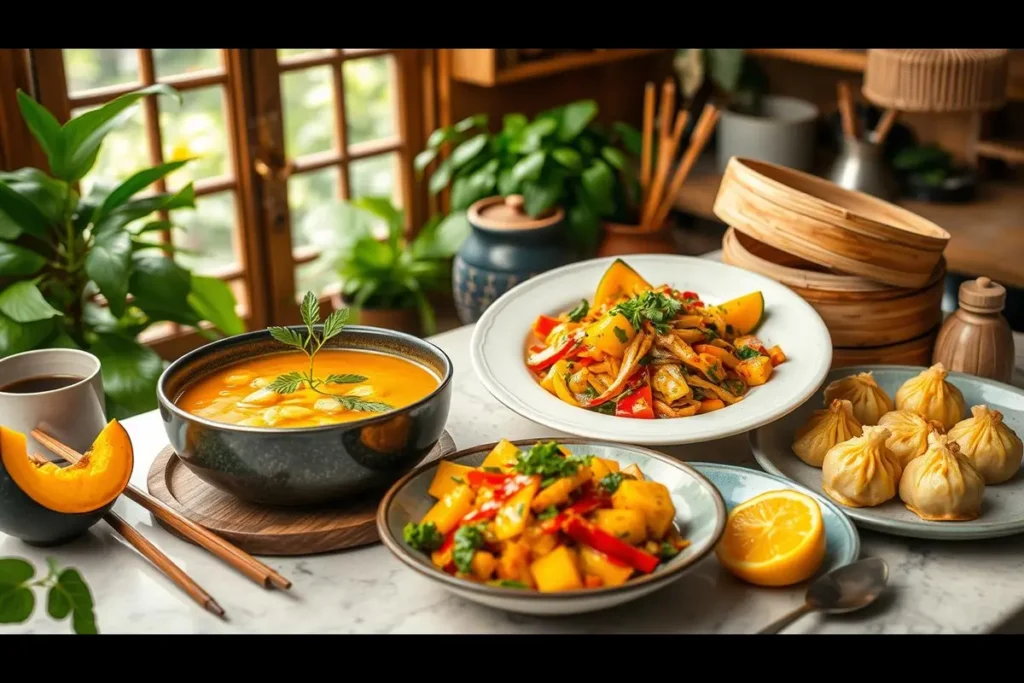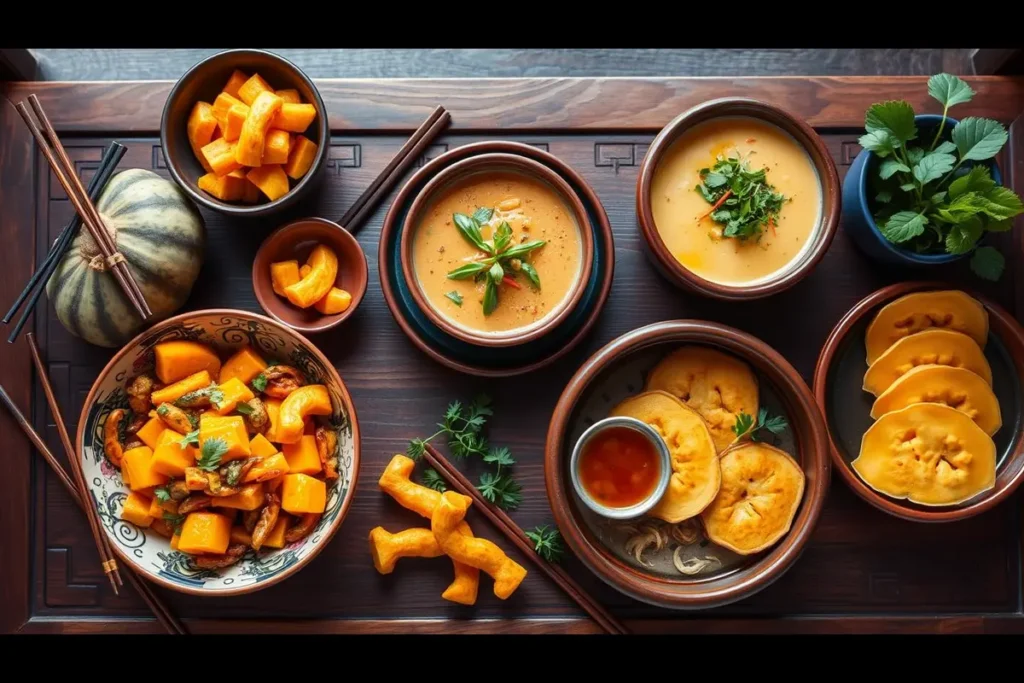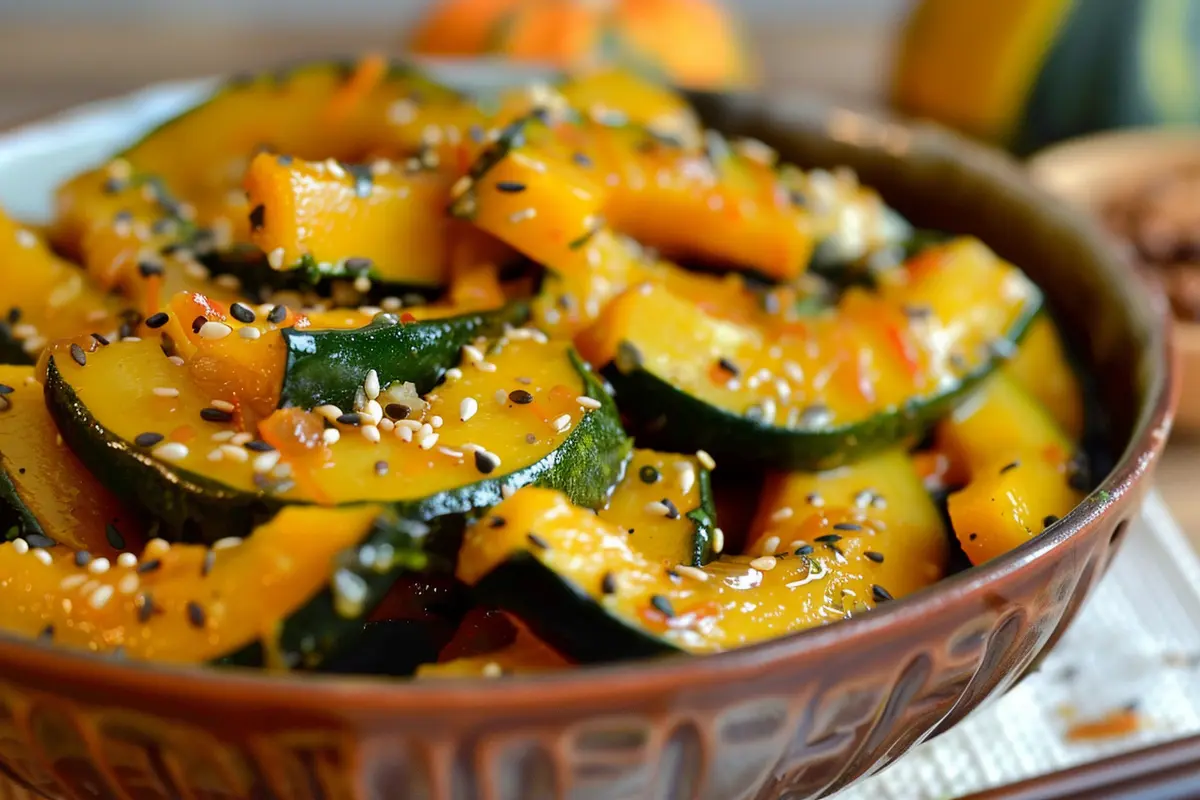Welcome to our article on delicious vegan kabocha squash dishes. We’ll explore the wonderful world of chinese squash recipes kabocha vegan. Kabocha squash is a type of winter squash used in Chinese cuisine. It’s known for its sweet and nutty flavor.
We’ll look at different ways to prepare kabocha squash. From traditional Chinese recipes to modern vegan interpretations, we’ve got you covered.
In this article, we’ll give you the inspiration and guidance you need. Whether you’re a seasoned chef or a beginner, you’ll find valuable information. We’ll show you how to prepare kabocha squash and enjoy its unique flavor and nutritional benefits.

Our goal is to help you discover the versatility of kabocha squash. We’ll show you how it can be used in various vegan chinese kabocha recipes. From traditional Chinese dishes to modern fusion recipes, we’ll cover it all.
Key Takeaways
- Learn about the different types of chinese squash recipes kabocha vegan and how to prepare them
- Discover the nutritional benefits of kabocha squash and how it can be used in vegan chinese kabocha recipes
- Get inspiration from traditional Chinese recipes and modern vegan interpretations
- Learn how to choose and store kabocha squash for maximum freshness
- Explore the various ways to cook kabocha squash, from steaming to roasting and stir-frying
- Find out how to combine kabocha squash with other ingredients to create delicious and authentic chinese squash recipes kabocha vegan dishes
Introduction to Kabocha Squash in Chinese Cuisine
Kabocha squash is a key ingredient in Chinese cooking, loved for its sweet and nutty taste. It’s great for many dishes, like soups and stir-fries. It’s also a favorite for vegans, offering lots of plant-based recipe ideas.
What is Kabocha Squash?
Kabocha squash comes from Asia and has a dark green skin and orange flesh. It’s packed with vitamins, minerals, and antioxidants. This makes it a nutritious choice for a healthy diet.
Historical Use in Asian Cooking
For centuries, kabocha squash has been a staple in Asian cooking. It’s used in soups, stews, and stir-fries. It’s often mixed with garlic, ginger, and soy sauce for tasty dishes.

Why Choose Vegan Kabocha Dishes
Vegan kabocha dishes are gaining popularity for their eco-friendly benefits and health perks. They help reduce carbon footprint and support green farming. Plus, kabocha squash is full of nutrients, making it a great part of a balanced diet.
Essential Tools for Preparing Kabocha Squash
To make tasty kabocha squash dishes, you need the right tools. Kabocha squash cooking tips stress the need for a sharp knife. A good knife makes peeling and chopping easier.
You also need a vegetable peeler and a cutting board. A peeler helps remove the skin fast. A cutting board is great for chopping and dicing the squash. Here are more tools you should have:
- A large pot for boiling or steaming the squash
- A roasting pan for roasting the squash in the oven
- A set of kitchen utensils, such as a spoon and spatula, for stirring and serving
With these tools, you’ll be ready to cook delicious kabocha squash. A bit of practice will make you an expert. Soon, kabocha squash cooking tips will come naturally to you.

Selecting and Storing Your Kabocha Squash
Choosing the right kabocha squash is key for authentic Chinese squash dishes. Look for a squash that’s heavy, has a hard skin, and no soft spots. These are signs of a good squash.
Keep your squash fresh by storing it in a cool, dry spot. Avoid washing the squash before storing to prevent moisture damage. A soft cloth can clean off dirt. Stored right, your squash can last weeks, perfect for many Chinese dishes.
Choosing the Perfect Squash
- Look for a squash with a hard, dense skin
- Choose a squash that is heavy for its size
- Avoid squash with soft spots or bruises
Storage Tips for Maximum Freshness
Store your squash in a cool, dry place. You can also use a paper bag or breathable cloth to keep it humid.
Signs of Ripeness
A ripe squash feels slightly soft around the stem. The skin should be deep and rich in color. Look for these signs to get the best taste and texture for your dishes.
Basic Preparation Techniques
To make a tasty vegan kabocha squash stir fry, start with the right steps. Peeling and chopping the squash is key. Use a vegetable peeler to remove the skin, then chop it into small pieces.
After that, you can steam or roast the squash. Steaming keeps nutrients, while roasting adds a sweet flavor. For your stir fry, sauté the squash with garlic and ginger for extra taste.
Here are some basic steps to begin:
- Peel and chop the squash into bite-sized pieces
- Steam or roast the squash to bring out its natural sweetness
- Sauté the chopped squash in a little oil with some garlic and ginger
By using these techniques, you can make many delicious vegan kabocha squash dishes. Always pick fresh, ripe squash for the best taste and texture.
| Preparation Technique | Description |
|---|---|
| Peeling and Chopping | Remove the skin and chop the squash into bite-sized pieces |
| Steaming | Steam the squash to preserve its nutrients and natural sweetness |
| Roasting | Roast the squash to add a caramelized flavor and texture |
Chinese Squash Recipes Kabocha Vegan: Classic Dishes
Kabocha squash is a key ingredient in Chinese cuisine. It’s used in many dishes. Here are some healthy options to try:
For a healthy kabocha squash recipe roundup, you can’t go wrong with steamed kabocha with garlic sauce. Also, try five-spice roasted kabocha and stir-fried kabocha with black bean sauce. These dishes highlight the squash’s unique taste and texture.
Steamed Kabocha with Garlic Sauce
This dish is a great way to start with kabocha squash. It’s simple yet flavorful. The squash is steamed and served with a garlic sauce that brings out its natural sweetness.
Five-Spice Roasted Kabocha
Roasting kabocha squash with five-spice powder makes for a spicy and aromatic dish. This spice blend adds a rich flavor to the squash. It’s perfect as a side or main course.
Stir-Fried Kabocha with Black Bean Sauce
This stir-fry combines kabocha squash’s sweetness with black bean sauce’s savory taste. It’s quick to make and great for a weeknight dinner.
These classic Chinese dishes are not only tasty but also healthy. Adding kabocha squash to your meals can bring many health benefits.
| Dish | Ingredients | Preparation Time |
|---|---|---|
| Steamed Kabocha with Garlic Sauce | Kabocha squash, garlic, soy sauce | 20 minutes |
| Five-Spice Roasted Kabocha | Kabocha squash, five-spice powder, olive oil | 30 minutes |
| Stir-Fried Kabocha with Black Bean Sauce | Kabocha squash, black bean sauce, bell peppers | 25 minutes |
Seasonal Cooking Tips for Kabocha
Exploring chinese squash recipes kabocha vegan means knowing when to use kabocha squash. Its flavor and texture are perfect for many dishes, from summer salads to winter stews.
In summer, kabocha squash is great with fresh herbs and citrus. It’s perfect for vegan salads and stir-fries. As fall arrives, roast it with warm spices for a side dish. In winter, it’s essential in hearty stews and soups.
Here are some tasty chinese squash recipes kabocha vegan dishes for each season:
- Summer: Kabocha squash and avocado salad with citrus vinaigrette
- Fall: Roasted kabocha squash with five-spice powder and roasted veggies
- Winter: Kabocha squash and lentil stew with steamed bok choy
Choosing the right cooking method is key to enjoying kabocha squash. Whether steaming, roasting, or stir-frying, kabocha vegan dishes will impress you.
Creative Fusion Recipes
Exploring vegan Chinese kabocha recipes is an exciting journey. It’s especially thrilling when you mix it with flavors from around the world. Easy kabocha squash dishes can become even more special by adding different cooking styles. Let’s dive into the world of creative fusion recipes, where Chinese flavors meet global tastes, creating new and tasty dishes.
Fusion cuisine is all about trying new flavors and ingredients. Mixing Chinese richness with Italian boldness can lead to amazing vegan Chinese kabocha recipes. Here are some examples:
- Kabocha squash ravioli with a Chinese-inspired filling
- Stir-fried kabocha with Italian seasonings and herbs
- Kabocha squash risotto with a hint of Chinese spices
These fusion recipes show how versatile kabocha squash is. They also prove that making easy kabocha squash dishes can be fun and rewarding. Whether you’re a pro in the kitchen or just starting, trying fusion recipes can be a great adventure. It lets you find new flavors and techniques to make your vegan Chinese kabocha recipes even better.
As we keep exploring fusion recipes, we’ll find even more tasty ways to make easy kabocha squash dishes. This will make kabocha squash a key ingredient in vegan Chinese cuisine.
Nutritional Benefits of Kabocha in Plant-Based Diets
Kabocha squash is packed with nutrients, making it great for plant-based diets. It’s full of vitamin A and fiber, which are key for a healthy diet. If you’re searching for healthy kabocha squash recipe roundup, you’ll find many tasty options.
Kabocha squash is a powerhouse of vitamins and minerals. It’s loaded with vitamins A and C, and minerals like potassium and iron. Plus, it’s high in fiber, which is good for your digestive health. Pairing it with tofu, tempeh, and seitan makes for a nutritious meal. Here are some key benefits:
- High in vitamin A and fiber
- Rich in minerals like potassium and iron
- Supports digestive health
- Can be paired with other plant-based ingredients for a well-rounded meal
Looking for plant-based kabocha recipe ideas? There are plenty of dishes you can make. Try soups, stews, salads, or stir-fries to add nutrition and flavor. Adding kabocha squash to your meals can make your diet healthier and more balanced.
Common Cooking Challenges and Solutions
Working with kabocha squash can bring up some common cooking challenges. These can affect the quality of your Chinese squash dishes. To solve these problems, it’s key to know how to prepare and cook the squash right. By using expert tips, your dishes will be tasty and full of flavor.
Some common issues include tough squash, the wrong texture, and flavor balance. Here are some tips to help you:
- Choose the right cooking method: Steaming or roasting can highlight the squash’s natural sweetness. Stir-frying adds a nice texture and flavor.
- Use high-quality ingredients: Fresh spices, herbs, and seasonings can make your squash dishes even better.
- Don’t overcook: Overcooking can make the squash mushy. Aim for a tender but firm texture.
By mastering these tips and techniques, you can make many delicious Chinese squash dishes. These dishes will impress your family and friends. Whether you’re experienced or new in the kitchen, with practice, you can overcome cooking challenges and succeed with kabocha squash.
“The key to cooking with kabocha squash is to understand its unique characteristics and adapt your techniques accordingly. With a little practice and experimentation, you can unlock the full flavor and potential of this amazing ingredient.”
Sauce Pairings and Seasoning Guide
Preparing tasty chinese squash recipes kabocha vegan needs the right sauce pairings and seasonings. Traditional Chinese seasonings like soy sauce, ginger, and garlic are great. They bring out the natural sweetness of kabocha squash.
There are also many vegan sauce alternatives to try. Tamari and nutritional yeast add a rich, savory taste. For a spicy kick, Szechuan pepper and five-spice powder are perfect.
Exploring Spice Combinations
Try different spice mixes to create unique flavors for your kabocha squash dishes. Here are some favorites:
- Ginger and garlic for a classic Chinese taste
- Szechuan pepper and five-spice powder for a bold, aromatic flavor
- Nutritional yeast and tamari for a cheesy, savory taste
Using these sauce pairings and seasonings in your chinese squash recipes kabocha vegan can lead to many tasty dishes. Whether you want a hearty vegan kabocha squash stir fry or a comforting soup, the right seasonings and sauces make a big difference.
| Seasoning | Flavor Profile |
|---|---|
| Soy Sauce | Salty, umami |
| Ginger | Spicy, aromatic |
| Five-Spice Powder | Complex, slightly sweet |
Menu Planning with Kabocha Dishes
Kabocha squash can be used in many ways in your meals. You can make easy kabocha squash dishes like soups and salads. Or, you can try more complex recipes like stir-fries and roasted dishes. Here are some plant-based kabocha recipe ideas to start with:
Here are some popular ways to use kabocha squash:
- Adding it to soups and stews for extra nutrition and flavor
- Roasting it as a side dish, seasoned with herbs and spices
- Using it in stir-fries and sautés, paired with other vegetables and plant-based protein sources
To make meal planning easier, try batch cooking and meal prep. These methods save time and ensure healthy meals all week. With a bit of creativity and planning, you can enjoy easy kabocha squash dishes and plant-based kabocha recipe ideas every day.
Conclusion: Embracing the Versatility of Vegan Kabocha Cooking
Our journey through vegan kabocha squash recipes shows how versatile this ingredient is. It brings a world of flavors to your table. From traditional Chinese dishes to new creations, kabocha’s sweetness and creamy texture are perfect for vegans.
Whether you’re new to vegan cooking or a seasoned pro, we hope you’re inspired. Kabocha can be used in many ways, from stir-fries to desserts. It’s a great way to add variety and nutrition to your meals.
We invite you to share your kabocha squash recipes and stories. Join the vegan community and discover more about this amazing ingredient. Let’s keep exploring and inspiring each other to enjoy healthy, tasty plant-based meals.
FAQ: Kabocha Squash
Kabocha squash is highly versatile and commonly used in a variety of dishes, including:
– Soups and stews
– Stir-fries with vegetables and sauces
– Roasted side dishes
– Vegan curries
– Purees for desserts or savory dishes Its naturally sweet and nutty flavor makes it an excellent ingredient for both savory and sweet recipes.
Yes, kabocha squash is renowned for its sweet, nutty, and slightly earthy flavor. Its creamy texture and rich taste make it a favorite in many cuisines, particularly in Asian dishes like soups and stir-fries. When roasted, its flavor becomes even sweeter and caramelized.
Yes, the skin of kabocha squash is edible when cooked. It becomes tender and soft, making it unnecessary to peel for many recipes, such as roasting or steaming. However, if the recipe calls for a smooth texture, such as purees or soups, you may want to peel the squash before cooking.
Both butternut and kabocha squash are nutritious, but they have some differences:
Butternut squash has slightly more vitamin C and potassium but is slightly higher in calories and carbs. If you’re looking for a lower-carb option with a richer flavor, kabocha squash is a better choice. For a milder flavor and higher vitamin C content, butternut squash is ideal. Both are excellent additions to a healthy diet.
Kabocha squash is lower in calories and carbs but higher in beta-carotene, vitamin A, and antioxidants.

